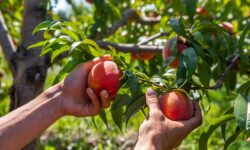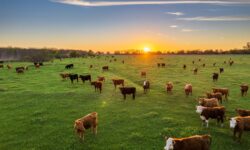Extreme weather throughout the year will cause a shortage of stone fruit in BC: We…
We have long understood the impact of greenhouse gas emissions on our climate, and yet the amount we emit into our atmosphere continues to increase (1). According to the Intergovernmental Panel on Climate Change, a United Nations body dedicated to providing scientific research related to climate change, “the concentrations of CO2 in the earth’s atmosphere may even become double by the middle of the 21st century with disastrous environmental consequences” (2). In order to prevent this dystopian future, scientists have been calling not only for strategies that reduce the world’s production of greenhouse gas emissions, but also ways that we can sequester, or take out, existing carbon from the atmosphere.
Although reforestation (planting trees) and machines that pull carbon from the atmosphere are commonly highlighted strategies to address this issue, there is one massive solution that is largely undervalued: blue carbon.
What is blue carbon?
Blue carbon is defined as “the carbon sequestered in both living and non-living [things] in the ocean and coastal habitats” (3). Examples of ocean and coastal habitats include seagrass beds, seaweed, and mangrove forests (4). These ecosystems are able to absorb and store carbon through photosynthesis- the process of converting sunlight and other elements into energy used to grow (5).
The amount of carbon these marine habitats are able to take out of the atmosphere is incredible: Covering less than 2% of the ocean’s surface, they are responsible for sequestering roughly 50% of all carbon absorbed by the sea (6)!
How else are marine ecosystems important to the environment?
Beyond carbon sequestration, ocean and coastal habitats have other incredibly important benefits to the environment. Here are two examples:
- – Ecosystem Services: An ecosystem service is a direct or indirect benefit that a natural environment provides humans. In the context of seaweed, these “…serve as feeding and nursing grounds for many commercially important species” (7). With millions of people around the world relying on fishing and other forms of aquaculture, the protection and growth of these marine ecosystems is crucial to sustainability (8).
- – Seaweed as Biofuel: Although we need to drastically reduce our use of fossil fuels to mitigate climate change, only about 14% of energy currently comes from renewable resources (9). Biofuel, which is fuel made from organic matter, could drastically increase this percentage. Seaweed is specifically recognized as a biofuel to have huge potential at replacing fossil fuels since it can be grown in various environments and does not require land that would otherwise be used for food production (10).
Seaweed production in the Asian-Pacific region continues to grow quickly every year but it is far from being used to its full potential (11). One academic study found that if other countries could match China’s seaweed growth, they could offset a significant amount of their CO2 emissions(12).
How can you support this solution?
- 1. Support the growth of seaweed production by buying seaweed or products with seaweed as an ingredient.
- 2. Seek out opportunities to protect local habitats that reside near or in water bodies.
- 3. Connect to your member of parliament (MP)! Whether its a newly-elected MP or one who has represented your community in the past, make sure they know what matters to you.
Sources
- 1. Sinha, V. R. P., Lowell Fraley, and B. S. Chowdhry. “Carbon dioxide utilization and seaweed production.” Proceedings of NETL: First National Conference on Carbon Sequestration. Vol. 6. 2001.
- 2. Ibid.
- 3. Sondak, Calvyn FA, et al. “Carbon dioxide mitigation potential of seaweed aquaculture beds (SABs).” Journal of applied phycology 29.5 (2017): 2363-2373.
- 4. Ibid.
- 5. Ibid.
- 6. Ik Kyo Chung, Jung Hyun Oak, Jin Ae Lee, Jong Ahm Shin, Jong Gyu Kim, Kwang-Seok Park, Installing kelp forests/seaweed beds for mitigation and adaptation against global warming: Korean Project Overview, ICES Journal of Marine Science, Volume 70, Issue 5, September 2013, Pages 1038–1044, https://doi.org/10.1093/icesjms/fss206
- 7. Sondak, Calvyn FA, et al. “Carbon dioxide mitigation potential of seaweed aquaculture beds (SABs).” Journal of applied phycology 29.5 (2017): 2363-2373.
- 8. Ibid.
- 9. Turan, Gamze, and Amir Neori. “Intensive Sea weed aquaculture: a potent solution against global warming.” Seaweeds and their role in globally changing environments. Springer, Dordrecht, 2010. 357-372.
- 10. Ibid.
- 11. Ibid.
- 12. Ibid.




